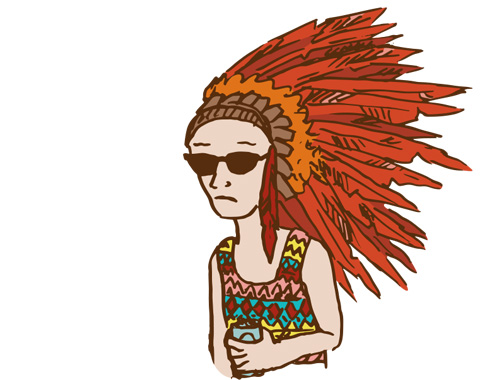Race is not a costume
Why you should avoid cultural appropriation this Halloween
October 27, 2015
This Halloween, allow two words to be the deciding factor between whether you should wear a certain costume or not: cultural appropriation.
A cliff-note definition of culture says that culture “consists of the beliefs, behaviors, objects, and other characteristics common to the members of a particular group or society. Through culture, people and groups define themselves.”
To be a part of a culture is to form an identity with certain beliefs, customs, foods, music, dances, that make up and belong to your specific group. Common examples of culture might include Japanese bowing as a sign of respect to their elders, or Middle Eastern friends kissing one another on the cheek as a way of saying hello. Ceviche, a shrimp appetizer, is a cultural food belonging to Mexican culture, whereas ceebu jen, a fish and rice dish, is a cultural relic of Senegalese culture.
In terms of wear, the ever-so-popular Native American headdress, less commonly known as war bonnets, are worn by Native Americans who are given great respect from their tribe. Headscarves are commonly worn by Muslim women as a symbol of modesty and devotion to God.
All of these examples are unique aspects of a specific group, from a specific region, that make up their culture. It belongs to them … and isn’t within our right as globally-competent, well-intentioned (for the most part) Americans wishing to dress up for a holiday to take from their culture and exotify their norms.
This is where the misconception of cultural exchange comes in.
Some may argue that dressing up as Pocahontas or a geisha is an example of cultural exchange. If some black girls may straighten their hair, can’t white girls get their hair corn-rowed? If an American Indian is dressing up as a Playboy Bunny, can’t white Americans dress up like glorified Disney princesses (despite the story of Pocahontas being notoriously butchered by Disney)? The answer is no. There isn’t a clear line between cultural exchange and cultural appropriation – there’s a lot of gray area. However, cultural exchange occurs when two cultures are within the same influence range and permit the exchange of culture. This is where power structures come in.
Ever since the wealthy, European colonized America and began one of the worst genocides in all of human history, white supremacy has ruled over America. Since the beginning, the colonizers were abusing and misusing the strength of the black slaves shipped from African countries during the slave trade. This country is built on the bones of the indigenous people as well as the backs of our African brothers and sisters. The Native Americans that weren’t slaughtered via white swords or infectious diseases carried by the oppressors were forced into boarding schools or concentrations camps, their language and culture beaten to the dirt while English and European customs were forced down their throats. Just a few centuries ago, African slaves were hardly considered humans, but more like remote controls: something you own, use, and throw out when it doesn’t work anymore.
This type of dehumanization desensitized the dominant white folk into racial issues we still see today, hence the need for hashtags like #blacklivesmatter. We’re supposed to believe that slavery ended, but it’s just been disguised and continually perpetuated through educational gaps, school to prison pipeline, unequal distribution of wages, and lack of opportunities and resources for people of color and ethnic minorities.
But wait, what does this have to do with power structure and cultural exchange?
It’s not an exchange of culture if the dominant race is taking and exotifying from a culture of less influence and power, simply to devalue that cultures norms in the form of a “costume.”
Are you ready to think twice about painting your face a different color or putting on that war bonnet now? Stay on the cultural respect side and dress up as a banana instead.































